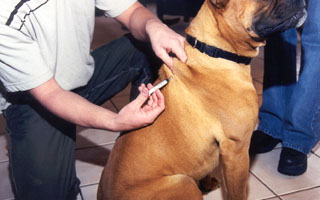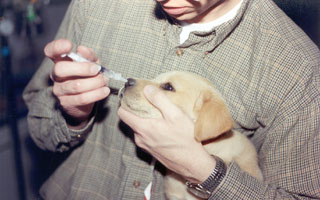The two most common routes to administer injections are subcutaneous (SQ) and
intramuscular (IM). A few vaccines and injections are given intranasal (IN) and
intravenous (IV). Giving injections by the improper route can result in product
failure and may result in local reactions.
Subcutaneous (SQ or SC)
A 1 inch needle of 22-25 gauge diameter is the best size of needle to use.
The loose skin on the top of the neck is a good location for SQ injections.
Substances injected SQ are not picked up by the blood supply as quickly as they
are if given IM. See figure 1 below.
Intramuscular (IM)
Drugs given IM are picked up by
the blood supply and spread very rapidly to all tissues of the body. A needle 1
inch in length and 20-22 gauge in diameter is recommended for giving IM
injections. The best location to give these injections is in the heavy muscles
of the leg. To avoid accidental intravenous (IV) administration, pull the
plunger back and make sure no blood appears in the syringe. If blood appears,
pull the needle completely out and re-insert the needle in a new site. To
help ensure that no damage is done to the nerves of the back leg, the needle
should be directed perpendicular to the body and inserted as far back on the leg
as possible.
Intranasal (IN)
Intranasal vaccines are packaged with special applicators that fit on the end
of a syringe. With the head tilted upwards, restrain the animal and squirt the
contents quickly into the nasal passages. The animal may sneeze, but this does
not reduce the effectiveness of the vaccination. Never inject an
intranasal product into muscle or under skin. See figure 2 below.
Intravenous (IV)
These injections should be reserved for the trained professional.
*See the following pictures for the exact locations for giving injections.

